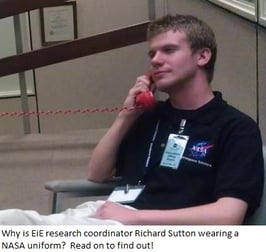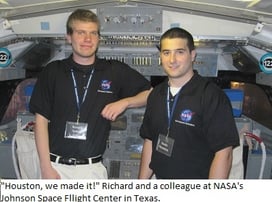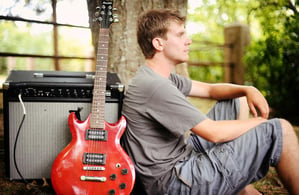 Occasionally on the EiE Blog, we introduce you to the folks on our team and the work they do. Today, meet Richard Sutton, research coordinator. We’ve got a mountain of data coming in from a major, NSF-funded study, and Richard is the gatekeeper. Student assessments, journals, performance evaluations . . . more than 200,000 pieces of data must be entered into our system, and Richard makes it happen.
Occasionally on the EiE Blog, we introduce you to the folks on our team and the work they do. Today, meet Richard Sutton, research coordinator. We’ve got a mountain of data coming in from a major, NSF-funded study, and Richard is the gatekeeper. Student assessments, journals, performance evaluations . . . more than 200,000 pieces of data must be entered into our system, and Richard makes it happen.
Richard is a noteworthy EiE’er for another reason. Over the past several months on the blog, we’ve been talking about engineering habits of mind. His personal story is a perfect example of the habit of mind of persistence.
Dreaming of Science from an Early Age
Engineering habits of mind are positive ways of thinking that kids develop when they engineer. When students engineer, we see them become more resilient and persistent—unfazed by failure and willing to try again. We can’t claim EiE shaped Richard’s thinking, because when he was a kid, growing up on Cape Cod, EiE didn’t exist yet.
But from an early age he had a passion for science—especially space and earth exploration. When his classmates were out playing sports, Richard could be found in the backyard playing “volcano hunter,” with the jungle gym for a volcano and the lawn as lava-encrusted terrain. “I also also visited the Museum of Science, Boston as a kid,” Richard says, “and it became my dream to work there some day.”
If at First You Don't Succeed, Apply Again for STEM
At Cape Cod Community College, he founded the STEM Club, assisted at a summer STEM camp for low-income kids, and took as many physics and astronomy classes as he could. He also applied for—and was accepted into—a special NASA Aerospace Scholar Program, for students earning two-year degrees. Participants get to travel to the Johnson Space Center in Houston for an on-site practicum—but only if they earn a certain score on coursework they do first at their home institution. Visiting Mission Control would have been a dream come true . . . but Richard didn’t make the cut.
That’s where the story could have ended. But Richard applied a second time, was accepted again, worked hard, and made the grade . . . and the trip to Texas. That summer, on the last day of STEM camp, he wore his NASA uniform and told the kids, “If you work hard, you can achieve YOUR dream, too.”
Making a Dream Come True
 After graduation, Richard moved to Boston and looked for work. He applied for jobs at the Museum . . . four different times. “I was not going to give up,” he says. Eventually, he was offered a part-time job at the ticket counter.
After graduation, Richard moved to Boston and looked for work. He applied for jobs at the Museum . . . four different times. “I was not going to give up,” he says. Eventually, he was offered a part-time job at the ticket counter.
It wasn’t exactly his dream job. But he took it. And during his first week, at employee orientation, he met another new staffer who was going to be working for EiE. “When I heard about EiE, I said, ‘This is absolutely something I want to be a part of,’” Richard says. He kept an eye on the internal job postings—and now, he’s part of our team.
 These days, Richard has some new goals. He plays guitar with his cousin, and they’re trying to take it to the next level. “By the end of the summer, we want to be in a room with a hundred people clapping for us,” he says.
These days, Richard has some new goals. He plays guitar with his cousin, and they’re trying to take it to the next level. “By the end of the summer, we want to be in a room with a hundred people clapping for us,” he says.
As for work goals, the Museum supports employees in taking continuing ed classes relevant to their work, and Richard is looking into classes that will further his education. “I think what we’re doing here at EiE is really important,” he says. “I’d like to pursue a career in research.”
When that happens, he’ll understand better than most young researchers what goes into managing masses of data. And we’re absolutely confident he’ll put his powers of persistence to good use!
Engineering is Elementary is a project of the National Center for Technological Literacy at the Museum of Science, Boston.








